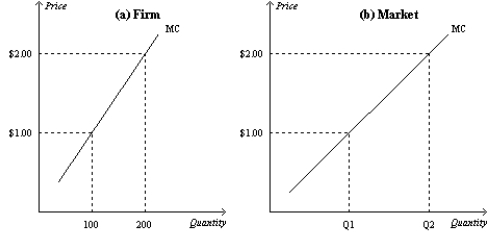A) $9.
B) $11.
C) $13.
D) $15.
Correct Answer

verified
Correct Answer
verified
Multiple Choice
Suppose a firm in a competitive market earned $1,000 in total revenue and had a marginal revenue of $10 for the last unit produced and sold. What is the average revenue per unit, and how many units were sold?
A) $5 and 50 units
B) $5 and 100 units
C) $10 and 50 units
D) $10 and 100 units
Correct Answer

verified
Correct Answer
verified
Multiple Choice
Mr. Rogers sells colored pencils. The colored-pencil industry is competitive. Mr. Rogers hires a business consultant to analyze his company's financial records. The consultant recommends that Mr. Rogers increase his production. The consultant must have concluded that Mr. Roger's
A) total revenues equal his total economic costs.
B) marginal revenue exceeds his total cost.
C) marginal revenue exceeds his marginal cost.
D) marginal cost exceeds his marginal revenue.
Correct Answer

verified
Correct Answer
verified
Multiple Choice
In a long-run equilibrium, the marginal firm has
A) price equal to minimum marginal cost.
B) total revenue equal to total cost.
C) accounting profit equal to zero.
D) All of the above are correct.
Correct Answer

verified
Correct Answer
verified
Multiple Choice
If the profitmaximizing quantity of production for a competitive firm occurs at a point where the firm's average total cost of production is falling as production increases, then the firm
A) will be earning positive economic profit at the profit-maximizing quantity.
B) will have economic profit less than zero at the profit-maximizing quantity.
C) will have zero economic profit at the profit-maximizing quantity.
D) should increase the quantity of production to increase profit.
Correct Answer

verified
Correct Answer
verified
Multiple Choice
Table 14-11
Suppose that a firm in a competitive market faces the following prices and costs:
 -Refer to Table 14-11. The marginal revenue from producing the 5th unit equals i) $6.
Ii) the price.
Iii) the marginal cost.
-Refer to Table 14-11. The marginal revenue from producing the 5th unit equals i) $6.
Ii) the price.
Iii) the marginal cost.
A) i) only
B) i) and ii) only
C) iii) only
D) i) , ii) , and iii)
Correct Answer

verified
Correct Answer
verified
Multiple Choice
Scenario 14-4 Victor is the recipient of $1 million from a lawsuit. Victor decides to use the money to purchase a small business in Florida. His business operates in a perfectly competitive industry. If Victor would have invested the $1 million in a risk-free bond fund, he could have earned $100,000 each year. After he bought the small business, Victor quit his job as a market analyst with Research, Inc., where he used to earn $75,000 per year. -Refer to Scenario 14-4. At the end of the first year of operating his new business, Victor's accountant reported an accounting profit of $150,000. What was Victor's economic profit?
A) -$150,000
B) -$50,000
C) -$25,000
D) $25,000
Correct Answer

verified
Correct Answer
verified
Multiple Choice
Suppose that a firm operating in perfectly competitive market sells 100 units of output. Its total revenues from the sale are $500. Which of the following statements is correct? i) Marginal revenue equals $5. Ii) Average revenue equals $5. Iii) Price equals $5.
A) i) only
B) iii) only
C) i) and ii) only
D) i) , ii) , and iii)
Correct Answer

verified
Correct Answer
verified
Multiple Choice
If there is an increase in market demand in a perfectly competitive market, then in the short run prices will
A) rise.
B) remain unchanged at the minimum of average total cost.
C) fall.
D) remain unchanged at the minimum of marginal cost.
Correct Answer

verified
Correct Answer
verified
Multiple Choice
Figure 14-9
In the figure below, panel a) depicts the linear marginal cost of a firm in a competitive market, and panel b) depicts the linear market supply curve for a market with a fixed number of identical firms.
 -Refer to Figure 14-9. If there are 300 identical firms in this market, what level of output will be supplied to the market when price is $2.00?
-Refer to Figure 14-9. If there are 300 identical firms in this market, what level of output will be supplied to the market when price is $2.00?
A) 300
B) 6,000
C) 30,000
D) 60,000
Correct Answer

verified
Correct Answer
verified
Multiple Choice
Table 14-2
The table represents a demand curve faced by a firm in a competitive market.
 -Refer to Table 14-2. For this firm, the average revenue from selling 3 units is
-Refer to Table 14-2. For this firm, the average revenue from selling 3 units is
A) $12.
B) $4.
C) $3.
D) $1.
Correct Answer

verified
Correct Answer
verified
Multiple Choice
When fixed costs are ignored because they are irrelevant to a business's production decision, they are called
A) explicit costs.
B) implicit costs.
C) sunk costs.
D) opportunity costs.
Correct Answer

verified
Correct Answer
verified
Multiple Choice
When firms are said to be price takers, it implies that if a firm raises its price,
A) buyers will go elsewhere.
B) buyers will pay the higher price in the short run.
C) competitors will also raise their prices.
D) firms in the industry will exercise market power.
Correct Answer

verified
Correct Answer
verified
Multiple Choice
In the long run, a profit-maximizing firm will choose to exit a market when
A) average fixed cost is falling.
B) variable costs exceed sunk costs.
C) marginal cost exceeds marginal revenue at the current level of production.
D) total revenue is less than total cost.
Correct Answer

verified
Correct Answer
verified
Multiple Choice
Which of the following statements best reflects the production decision of a profit-maximizing firm in a competitive market when price falls below the minimum of average variable cost?
A) The firm will continue to produce to attempt to pay fixed costs.
B) The firm will immediately stop production to minimize its losses.
C) The firm will stop production as soon as it is able to pay its sunk costs.
D) The firm will continue to produce in the short run but will likely exit the market in the long run.
Correct Answer

verified
Correct Answer
verified
Multiple Choice
By comparing marginal revenue and marginal cost, a firm in a competitive market is able to adjust production to the level that achieves its objective, which we assume to be
A) maximizing total revenue.
B) maximizing profit.
C) minimizing variable cost.
D) minimizing average total cost.
Correct Answer

verified
Correct Answer
verified
Multiple Choice
In a competitive market with identical firms,
A) an increase in demand in the short run will result in a new price above the minimum of average total cost, allowing firms to earn a positive economic profit in both the short run and the long run.
B) firms cannot earn positive economic profit in either the short run or long run.
C) firms can earn positive economic profit in the long run if the long-run market supply curve is upward sloping.
D) free entry and exit into the market requires that firms earn zero economic profit in the long run even though they may be able to earn positive economic profit in the short run.
Correct Answer

verified
Correct Answer
verified
Multiple Choice
Suppose a profit-maximizing firm in a competitive market produces rubber bands. When the market price for rubber bands falls below the minimum of its average total cost, but still lies above the minimum of average variable cost, in the short run the firm will
A) experience losses but will continue to produce rubber bands.
B) shut down.
C) earn both economic and accounting profits.
D) raise the price of its product.
Correct Answer

verified
Correct Answer
verified
True/False
A miniature golf course is a good example of where fixed costs become relevant to the decision of when to open and when to close for the season.
Correct Answer

verified
Correct Answer
verified
Multiple Choice
Table 14-14
The following table presents cost and revenue information for Bob's bakery production and sales.
 -Refer to Table 14-14. What is the total revenue from selling 5 units?
-Refer to Table 14-14. What is the total revenue from selling 5 units?
A) $2.50
B) $3.25
C) $12.50
D) $16.25
Correct Answer

verified
Correct Answer
verified
Showing 41 - 60 of 543
Related Exams